Research Projects
Well-designed stimuli-responsive polymers have attracted much interest as precursors of advanced polymer materials such as nano-organized self-assemblies, intelligent hydrogels, and DDS. In particular, recent progress in living (or precision) polymerization has encouraged us to design various types of amphiphilic block copolymers or hydrophobically modified water-soluble polymers in order to examine their stimuli-induced self-association. In the field of polymer micelles, for example, micelles with multiple morphologies, covalently cross-linked micelles such as shell cross-linked knedels, and thermosensitive micelles have been prepared by living polymerization techniques. Furthermore, the characteristic micellization and gelation properties of PEO-based block copolymers with relatively low molecular weights such as PEO-b-PPO-b-PEO and PEO-b-poly(alkylene oxide) have been investigated in detail by many physical chemists.
We have prepared a variety of functional
polymers with well-controlled structures and molecular
weights by living cationic polymerization in the presence of
an added base. For example, poly(vinyl ether)s with side
oxyethylene units and ω-alkyl groups obtained by living
cationic polymerization were found to exhibit
thermally-induced phase separation in water. Further
investigation showed that (i) the temperatures of phase
separation (Tps) could be controlled by
substituting different side oxyethylene units or ω-alkyl
groups, (ii) the narrow molecular weight distribution (MWD)
of the polymer resulted in the high sensitivity of phase
separation, and (iii) block copolymers exhibited multistage
phase separation at the Tps of each block
segment, which is behavior considerably different from that
of homopolymers or random copolymers. On the basis of these
results, we have designed a new strategy for preparing block
copolymers with various types of stimuli-responsive
properties such as thermosensitive physical gelation.

Our recent achievements include the following topics:
(i) Living Cationic Polymerization in the Presence of a Weak Lewis Base
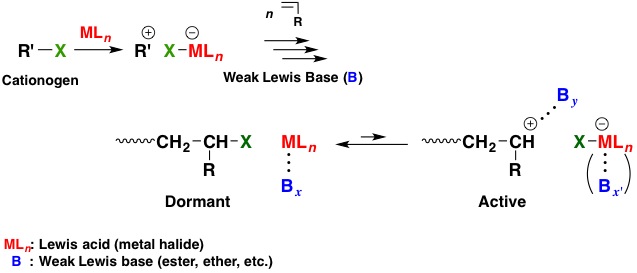
Living polymerization is an important tool to design and synthesize new polymer materials with controlled architecture (molecular weight, structure etc). During the last two decades, a concept of the living polymerization has expanded into various polymerization systems, including cationic polymerization, and their recent advances are especially impressive in quantity and quality. We have reported on the living cationic polymerization of vinyl ethers in the presence of added bases . For example, the polymerization of isobutyl vinyl ether (IBVE) with EtAlCl2 in conjunction with 1-(isobutoxy)ethyl acetate in the presence of a large excess of ethyl acetate or 1,4-dioxane as an added base, yields well-defined living polymers with a very narrow MWD (Mw/Mn < 1.1) even at higher polymerization temperature such as 40 ºC (Macromolecules 1989). In this system, the unstable growing carbocations are stabilized with a nucleophilic interaction of the added basic compounds. Recently, on the basis of this principle, various cationic polymerization systems have been developed (Chem. Rev. 2009 [Open Access]) to give living polymers by using externally added bases (electron donors, nucleophiles). This concept differs fundamentally from that for the previous living systems expressed as "stabilization of the growing propagating carbocation by counteranions".
(ii) Living Cationic Polymerization Using a Variety of Lewis Acid Catalysts

Lewis acid catalysts exhibit distinctive
characteristics depending on the central metals. Our study
demonstrated that a variety of metal chlorides function as
effective Lewis acid catalysts for living cationic
polymerization of vinyl ethers and styrene derivatives when
combined with a suitable additive (Macromolecules
2009 [Open Access], Macromolecules
2012). In particular, the balance between
chlorophilicity and oxophilicity of central metals was
highly responsible for the catalytic activity in the
base-assisting living cationic polymerization. Tolerance to
functional groups also differed among metal halide
catalysts. The development of initiating systems using a
variety of Lewis acid catalysts has broadened the scope of
polymerizable monomers.
(iii) Alternating Copolymerization of Vinyl Ethers and Conjugated Aldehydes

Conjugated aldehydes were demonstrated to copolymerize with vinyl ethers in a controlled manner to yield alternating copolymers (Macromolecules 2010 [Open Access]). The product copolymers have acetal moieties at periodic intervals; hence, the polymers are degraded into small molecules under acidic conditions. A variety of naturally occurring aldehydes, such as myrtenal and perillaldehyde, also function as a good comonomer for controlled alternating copolymerization (Macromolecules 2012). Moreover, stimuli-responsive copolymers with acid-degradability were prepared using vinyl ether monomers having a functional side chain (ACS Macro Lett. 2014). Polymers that have degradable points at predetermined positions were also successfully obtained via the sequential addition of a small amount of aldehyde monomers during living cationic polymerization of vinyl ethers (Polym. Chem. 2015).
(iv) Concurrent Cationic Vinyl-Addition and Ring-Opening Copolymerization

Copolymerization of different types of
monomers via different mechanisms has a great potential to
generating novel polymeric materials with various attractive
properties. However, attempts to copolymerizing different
types of monomers often result in the generation of
homopolymer mixtures or diblock-like copolymers due to the
difficulty in generating crossover propagation reactions. We
have recently achieved concurrent cationic vinyl-addition
and ring-opening copolymerization of vinyl ethers and
oxiranes (JACS
2013 [Open Access], Macromolecules
2014). Crossover reactions between vinyl and
cyclic monomers successfully occurred to yield copolymers
with multiblock or alternating sequences. In particular, the
generation of a tertiary or resonance-stabilized carbocation
via the ring-opening of the oxirane-derived oxonium ion was
indispensable for the crossover reaction from oxirane to
vinyl ether. The use of a suitable Lewis acid catalyst was
also of great importance for efficient copolymerization.
Terpolymerization of vinyl ether, oxirane, and ketone via
one-way cycle of crossover reactions was also achieved via
the concurrent cationic vinyl-addition, ring-opening, and
carbonyl-addition mechanisms (ACS
Macro Lett. 2015 [Open Access]).
(v) Quantitative Synthesis of Star-Shaped Polymers

Star-shaped polymers consisting of arm chains
and a core moiety were synthesized by the bundling reaction
of living propagating linear polymers with a divinyl
crosslinker. Under optimized conditions, the bundling
reaction of the living poly(vinyl ether) chains efficiently
proceeded to result in the star-shaped polymer formation in
quantitative yield (JACS
2006). Recently, quantitative synthesis of
star-shaped polymers having poly(styrene derivative)s as arm
chains was also achieved using a suitable divinyl compound
and an initiating system (Macromolecules
2016 [Open Access]). In addition, a “domino
method” was demonstrated to enable one-shot synthesis of
star-shaped polymers (JPSA
2012).
(vi) Precise Synthesis of Stimuli-Responsive Polymers with Well-Defined Primary Structures
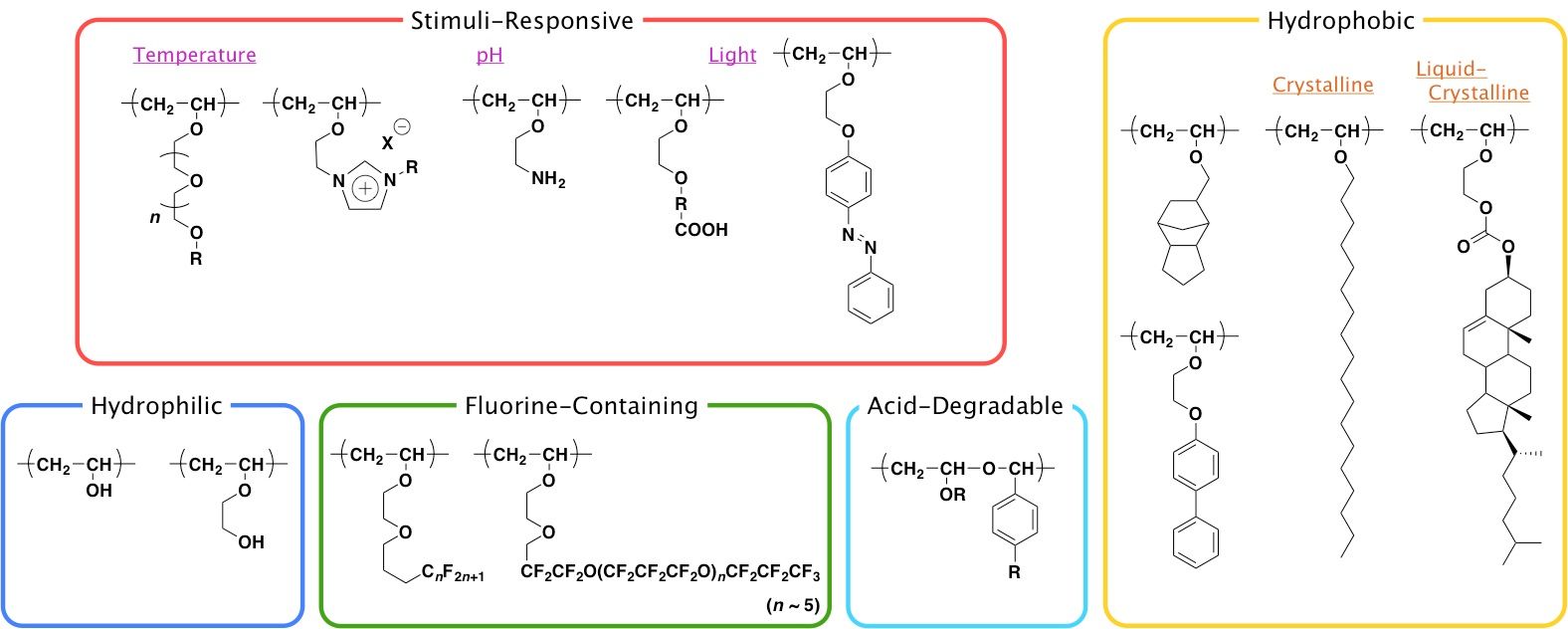
Vinyl ether polymers exhibit a variety of
functions depending on the functional groups introduced into
the side chains (Adv.
Polym. Sci. 2008). Representative examples of
functional poly(vinyl ether)s that we have obtained are
listed above. Polymers with oxyethylenic, carboxy, or azo
groups change properties in response to temperature, pH, or
light, respectively (JPSA
1992, JPSA
2013, JPSA
2005). Fluorine-containing polymers exhibit
high water- and oil-repellency on due to the fluorous
property (JPSA
2011). Poly(vinyl ether)s with hydrophobic
groups also exhibit unique properties, such as self-standing
film formation, crystalline property, and
liquid-crystallinity (JPSA
2008). More recently, poly(vinyl ether)s with
imidazolyl groups were found to exhibit UCST-type
thermoresponsive behavior in water (Macromolecules
2012 [Open Access]).
(vii) Design and Synthesis of Functional Polymers
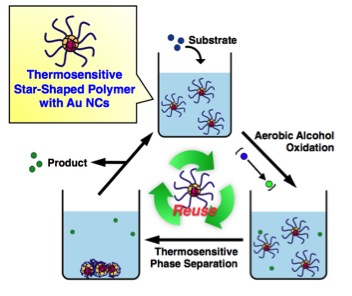
A star-shaped polymer having arm chains of poly(vinyl ether) with oxyethylenic side chains functioned as a good support for gold nanoclusters. Gold ions were reduced in the presence of the star-shaped polymer in water, which resulted in the formation of gold nanoclusters with a diameter of less than 4 nm. The gold nanoclusters supported on the star-shaped polymer exhibited an activity in aerobic alcohol oxidation. More interestingly, the gold nanoclusters retained its activity during the workup procedures without forming large aggregates. This research was conducted in collaboration with Prof. Tsukuda (present affiliation: The University of Tokyo) and Prof. Sakurai (present affiliation: Osaka University) of Institute of Molecular Science (JACS 2007).
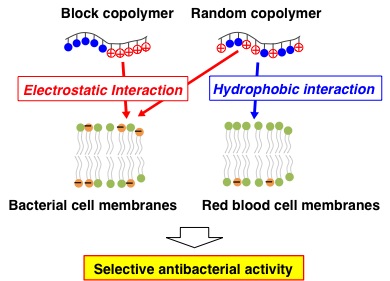
Sequences of copolymers were demonstrated to be responsible for the selective antibacterial property. An amphiphilic diblock copolymer consisting of amino group- and hydrophobic moiety-containing segments exhibited antibacterial activity, while negligibly active in hemolysis. This is in sharp contrast to the corresponding random copolymer, which exhibited both antibacterial and hemolytic activities. The difference in single-chain conformation between the block and random copolymers may be responsible for the different interaction with the cell membranes. This research was conducted in collaboration with Prof. Kuroda of University of Michigan and Prof. Sato of Osaka University (Biomacromolecules 2011).
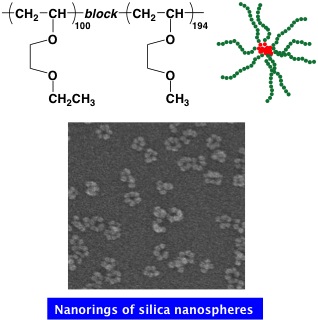
An amphiphilic block copolymer consisting of hydrophilic and hydrophobic segments mediated the selective assembly of silica nanospheres into nanorings. Neither random copolymers nor block copolymers with inappropriate lengths of both segments were effective for the nanoring formation, indicating that structures of polymers were highly responsible for the assembly mode of silica nanospheres. This research was conducted in collaboration with Prof. Sugawara-Narutaki (present affiliation: Nagoya University) of The University of Tokyo (Polym. J. 2015).
Selected Review Articles
1. A Renaissance in Living Cationic Polymerization (Chem. Rev. 2009 [Open Access])
2. New Stage in Living Cationic Polymerization: An Array of Effective Lewis Acid Catalysts and Fast Living Polymerization in Seconds (JPSA 2007)
3. Synthesis of Stimuli-Responsive Polymers by Living Polymerization: Poly(N-Isopropylacrylamide) and Poly(Vinyl Ether)s (Adv. Polym. Sci. 2008)
4. Concurrent cationic vinyl-addition and ring-opening copolymerization of vinyl ethers and oxiranes (Polym. J. 2016)